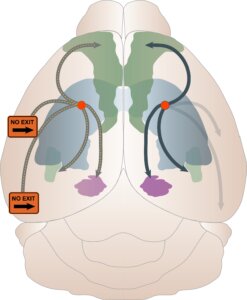#Policymakers should pre-plan for earthquake cordon use
“#Policymakers should pre-plan for earthquake cordon use”

Otago researchers examining the impacts of post-earthquake cordons on residents and businesses say policy makers should pre-plan for cordon use to minimize negative outcomes.
A team from the University of Otago’s Center for Sustainability has produced a paper examining the short and long-term impacts of post-earthquake cordons, using data collected on cordon use following the 6.3 magnitude Christchurch quake in 2011, and the 6.3 magnitude L’Aquila, Italy quake in 2009.
September 4, 2020 marks 10 years since the 7.2 magnitude Darfield earthquake, centered 40 kilometers west of Christchurch, which caused significant damage to central Christchurch and saw cordons introduced to restrict access to damaged areas.
The Otago study aims to address the gap in literature on the purpose, complexities and societal implications of post-earthquake cordons, particularly concerning impacts on housing, legal concerns, social welfare, the economy, civil liberties, and health.
Lead author Dr. Caroline Orchiston says the research should give policy makers and other stakeholders a good overview of what downstream consequences can be expected when cordons are established.
“In Wellington, local government is working hard to make their city more resilient, however a future major earthquake is still likely to require a cordon in parts of the central city. This research will help decision makers make informed decisions and suggests that pre-planning for cordons is very important in a seismically active country like New Zealand.”
The potential for post-earthquake cordons to be set up for longer time periods means civil liberties could be restricted, and public confidence may erode while the rebuild, reconstruction and recovery processes may be streamlined or delayed, she says.
“Cordons are set up mainly to protect public safety. For cordons to be effective, people have to abide by the rules. This can be challenging if your business or property is within the cordon, as we saw after the February 2011 earthquake,” she says.
About 6000 Christchurch businesses and 50,000 jobs were displaced after the Christchurch earthquake, with 58 percent of CBD businesses recording revenue decreases, and 31 percent closing permanently.
An inability to access business premises within a cordoned area, even if its services are operational, can cause disruption such as lack of access to cash, data stored on computers, documents, or stock.
In terms of residential impacts, displacement of those living within a cordon can place pressure on surrounding housing resources, which could be exacerbated if an influx of rebuild workers follows during the post-earthquake recovery phase.
Even when transitional housing was supplied after the L’Aquila, Italy quake, issues arose on durability, maintenance, lack of services and public transport, and questionable ecological, urban and safety values.
The study found that in cases of mandatory evacuation, it could be assumed an individual would have the ability to return to their property once an evacuation was over, but if a cordon was in place, an individual’s personal property may be stranded for some time, or even lost permanently if their building is condemned.
“Cordon managers may wish to provide flexibility in cordon access if deemed safe to do so,” says Dr. Orchiston.
“Such flexibility may encourage residents to evacuate quickly in the event of an earthquake, rather than spend time gathering valuables before leaving.”
Further impacts of post-earthquake cordons included the psychological effect of loss of/stranding of pets, and adverse impacts on physical, mental and emotional health.
However, researchers found if a cordon was well managed, it could influence public confidence in the government’s recovery response.
There is a growing acknowledgement by policy makers, academics and relevant stakeholders that cordons are a necessary and very useful disaster management tool, and when applied effectively, can support the recovery of a city and its people after a major seismic event, Dr. Orchiston says.
Co-authors Shakti Raj Shrestha and Greg Underwood suggest the research highlights that cordon operations and decisions are a complex undertaking, and the paper provides a good information base which can be used to pre-plan for cordon establishment.
“When NZ experiences another major urban earthquake in future, we will do much better if we’ve already given careful consideration to cordon management and decision-making,” says Mr Shrestha.
The research is relevant to studies of law, governance, disaster management, economics, and social wellbeing, including temporary housing, evacuation and social and economic recovery, he says.
Citation:
Policymakers should pre-plan for earthquake cordon use (2020, September 3)
retrieved 3 September 2020
from https://phys.org/news/2020-09-policymakers-pre-plan-earthquake-cordon.html
This document is subject to copyright. Apart from any fair dealing for the purpose of private study or research, no
part may be reproduced without the written permission. The content is provided for information purposes only.
If you want to read more Like this articles, you can visit our Science category.
if you want to watch Movies or Tv Shows go to Dizi.BuradaBiliyorum.Com for forums sites go to Forum.BuradaBiliyorum.Com




